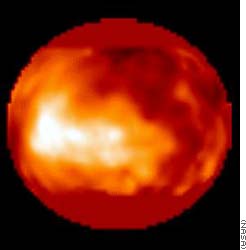New research claims methane clouds and rain on Titan

In one of the most distant weather reports ever received, clouds and even rain showers are visible at various points on Titan, Saturn's largest moon. Combined with massive suns and medium-sized mountains, the picture that emerges is of a place that most closely resembles Earth than any other place in the solar system. The scientists have even called Titan a hot spot in the search for extraterrestrial life and new work in the field is increasing the excitement.
Titan is a cold, dark and smog-shrouded world. It is larger than the planet Mercury and almost half the size of Earth. It has also been known for several decades as the only moon in the solar system that contains an atmosphere. Titan has many of the raw materials of life, including nitrogen, carbon and water. But at a distance of 1.4 billion km from the sun, most, if not all, of Titan's water is locked in ice, so that the rain that falls in various places on the surface of the Saturnian moon is mostly made of methane - the main component of the natural gas used for heating on Earth. Methane is also an important component of other organic compounds.
In a new study, the researchers observed light outside the visible range emitted by Titan, and saw in it small clouds that appear and disappear within a day, mainly after raining methane. The results of the study, which confirmed previous suspicions about the similarity of its atmosphere to that of the Earth, were published in the October 20, 2000 issue of the monthly Science. Titan is a laboratory the size of a planet, containing everything necessary for organic chemistry - reactions that might have started life 4 billion years ago on Earth." says Jonathan Lunine - a professor in the Laboratory for Planets and Moons, who actually did not participate in the research. "Seeing the methane in action as a cloud maker and rainmaker shows that Titan is an attractive place for exobiology researchers.
On Earth, the weather is driven mainly by the sun's heat, which creates temperature differences and causes a massive transfer of winds, and spurs the ocean currents, but Titan receives only one percent of the energy from the sun, and its temperatures hover around minus 178 degrees Celsius, so we have to look Another force that drives the weather on Titan, pretty mild weather by earthly standards. "We suggest looking for capsule heat (released when gas condenses) as playing a role in driving Titan's weather." says Caitlin Griffith, the Hershit researcher. "The bizarre conditions cause strange clouds to form. On Titan, clouds are rare, typically covering only 50 percent of the surface of the sphere, compared to Earth's XNUMX percent cloud coverage.”
"Titan's gravity is only one-seventh that of Earth. The extreme cold also means an energy-poor atmosphere, which does not escape from such a weak gravity. Thus Titan's atmosphere is denser than Earth's and extends higher into the sky.
Titan's clouds hover at an altitude of 25 miles, says Griffith, a researcher at Northern Arizona University in Flagstaff. The clouds of the earth move from the level of the earth's surface up to a height of about 18 km in the center of the most severe thunderstorms and hurricanes. While the weather on Titan is quite comfortable, and the showers are sparse, it can occasionally get wild. Most of the rivers on Titan are dry, but the river valleys are rich and deep. Researcher Ralph Lorenz of the Institute for the Study of Planets and Moons writes about the study.
The search for Titan life is gaining a place of honor in the list of sites for the search for extraterrestrial life. Like the fair moon Europa, Titan should hide flowing water, says Lorenz, who separately from the study published today, also conducted geophysical models of Titan.
Lorenz says that the surface is too cold for flowing water, which is the most necessary thing for life as we know it, but deep below the surface, it may be warm enough to melt the ice. Indeed, scientists have found simple organic molecules, similar to those of fuel for cars - on the foggy moon. These molecules are very far from life, but they are the first step towards it, says Lorenz. The only thing Titan has an advantage over Europa is the existence of these organic molecules. Lorenz says, adding that this allows Titan's atmosphere to conduct life-creating experiments."
There is no evidence that Titan or Europa are habitable, and scientists agree that we won't know until we do more research, from observations from space to direct tests. The answers may come in 2004. While Cassini will tour the Saturn system to study the planet, its rings and moons, it will launch a smaller spacecraft - Huygens into Titan's atmosphere.
The Huygens spacecraft will take measurements of Titan's atmosphere during two and a half hours of circling and hovering. On the surface, it is expected to survive and collect data for at least three minutes and possibly more. But hardware malfunctions recently encountered by Cassini may cause it to not receive most of the scientific data that the Huygens vehicle will collect. The European Space Agency, which is responsible for Huygens, hopes to conduct a program to fix the malfunctions next summer.
Not all scientists agree with Griffith's conclusion. "I don't think I can say anything for sure if these clouds exist or not," says Athena Coustenis from the Paris-Moton Observatory. According to her, there is still a need to verify the conclusions in independent studies.
